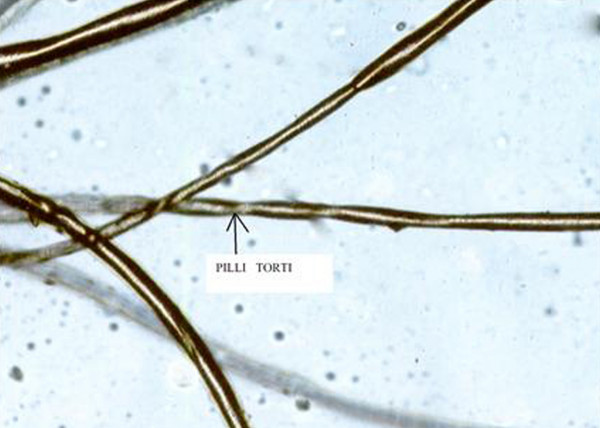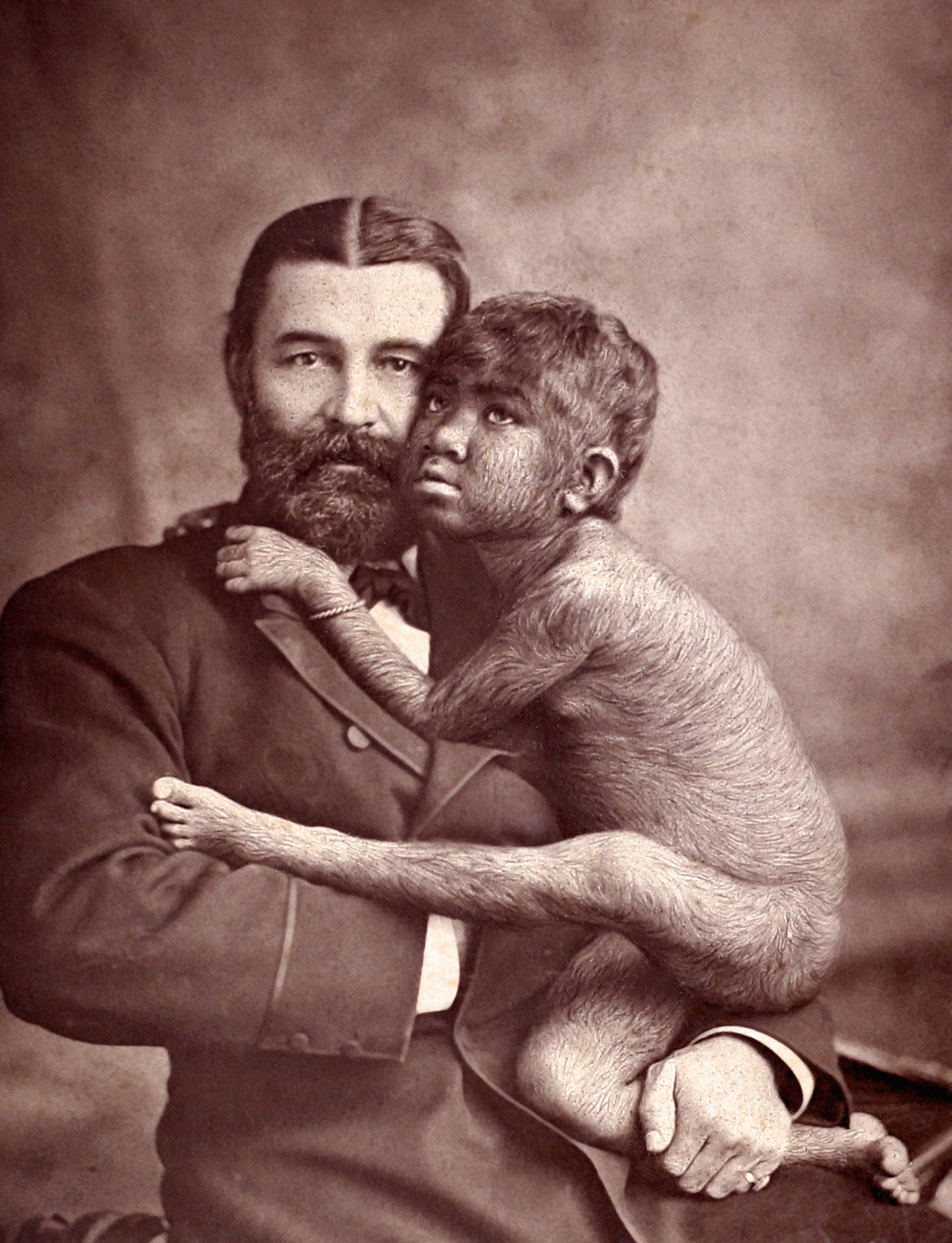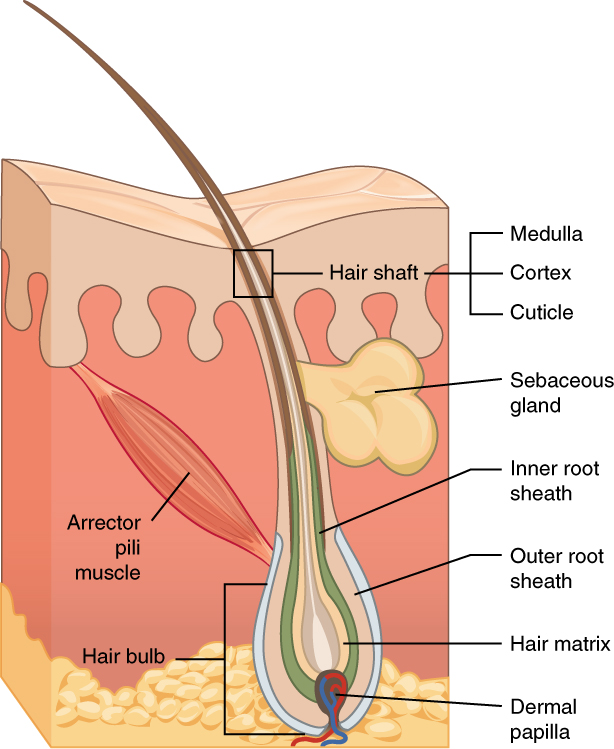|
Hair Disease
Hair diseases are illnesses that impact the persistence and regular growth of hair. Types of hair diseases include folliculitis, hirsutism, hypertrichosis, hypotrichosis (alopecia), Menkes kinky hair syndrome, monilethrix, and piedra. Folliculitis Folliculitis is an inflammatory response that occurs in the hair follicle's superficial part and may affect either the perifollicular or follicular opening. Hirsutism Hirsutism is characterized as the overgrowth of terminal hair in a typical male pattern distribution on a female's face and body. Hypertrichosis Hypertrichosis is any place of the body where there is more hair growth than is typically seen in people of the same age, race, and sex, excluding androgen-induced hair growth. Hypotrichosis Hypotrichosis is an uncommon condition where there is little to no hair development on the head, in the places of the body where hair normally grows, such as the brows above the eyes and the edges of the eyelids. Menkes k ... [...More Info...] [...Related Items...] OR: [Wikipedia] [Google] [Baidu] |
Hair Follicle
The hair follicle is an organ found in mammalian skin. It resides in the dermal layer of the skin and is made up of 20 different cell types, each with distinct functions. The hair follicle regulates hair growth via a complex interaction between hormones, neuropeptides, and immune cells. This complex interaction induces the hair follicle to produce different types of hair as seen on different parts of the body. For example, terminal hairs grow on the scalp and lanugo hairs are seen covering the bodies of fetuses in the uterus and in some newborn babies. The process of hair growth occurs in distinct sequential stages: ''anagen'' is the active growth phase, ''catagen'' is the regression of the hair follicle phase, ''telogen'' is the resting stage, ''exogen'' is the active shedding of hair phase and ''kenogen'' is the phase between the empty hair follicle and the growth of new hair. The function of hair in humans has long been a subject of interest and continues to be an impor ... [...More Info...] [...Related Items...] OR: [Wikipedia] [Google] [Baidu] |
Hirsutism
Hirsutism is excessive body hair on parts of the body where hair is normally absent or minimal. The word is from early 17th century: from Latin ''hirsutus'' meaning "hairy". It usually refers to a male pattern of hair growth in a female that may be a sign of a more serious medical condition, especially if it develops well after puberty. Cultural stigma against hirsutism can cause much psychological distress and social difficulty. Discrimination based on facial hirsutism often leads to the avoidance of social situations and to symptoms of anxiety and depression. Hirsutism is usually the result of an underlying endocrine imbalance, which may be adrenal, ovarian, or central. It can be caused by increased levels of androgen hormones. The amount and location of the hair is measured by a Ferriman–Gallwey score. It is different from hypertrichosis, which is excessive hair growth anywhere on the body. Treatments may include certain birth control pills, antiandrogens, or ins ... [...More Info...] [...Related Items...] OR: [Wikipedia] [Google] [Baidu] |
List Of Cutaneous Conditions
Many skin conditions affect the human integumentary system—the organ system covering the entire surface of the Human body, body and composed of Human skin, skin, hair, Nail (anatomy), nails, and related muscle and glands. The major function of this system is as a barrier against the external environment. The skin weighs an average of four kilograms, covers an area of two square metres, and is made of three distinct layers: the epidermis (skin), epidermis, dermis, and subcutaneous tissue. The two main types of human skin are: glabrous skin, the hairless skin on the palms and soles (also referred to as the "palmoplantar" surfaces), and hair-bearing skin.Burns, Tony; ''et al''. (2006) ''Rook's Textbook of Dermatology CD-ROM''. Wiley-Blackwell. . Within the latter type, the hairs occur in structures called pilosebaceous units, each with hair follicle, sebaceous gland, and associated arrector pili muscle. Embryology, In the embryo, the epidermis, hair, and glands form from the ectod ... [...More Info...] [...Related Items...] OR: [Wikipedia] [Google] [Baidu] |
Nodule (medicine)
In medicine, nodules are small firm lumps, usually greater than 1 cm in diameter. If filled with fluid they are referred to as cysts. Smaller (less than 0.5 cm) raised soft tissue bumps may be termed papules. The evaluation of a skin nodule includes a description of its appearance, its location, how it feels to touch and any associated symptoms which may give clues to an underlying medical condition. Nodules in skin include dermatofibroma and pyogenic granuloma. Nodules may form on tendons and muscles in response to injury, and are frequently found on vocal cords. They may occur in organs such as the lung, or thyroid, or be a sign in other medical conditions such as rheumatoid arthritis. Characteristics Nodules are small firm lumps usually greater than 1 cm in diameter, found in skin and other organs. If filled with fluid they are usually softer and referred to as cysts. Smaller (less than 0.5 cm) raised soft tissue bumps may be termed papules. Eva ... [...More Info...] [...Related Items...] OR: [Wikipedia] [Google] [Baidu] |
Piedra
Piedra is a hair disease caused by a fungus, which causes formation of nodules on the hair shaft.Veasey JV, Avila RB, Miguel BAF, Muramatu LH. White piedra, black piedra, tinea versicolor, and tinea nigra: contribution to the diagnosis of superficial mycosis. ''An Bras Dermatol''. 2017 May-Jun;92(3):413-416. Types include: * White piedra * Black piedra ''Piedraia hortae'' is a superficial fungus that exists in the soils of tropical and subtropical environments and affects both sexes of all ages. The fungus grows very slowly, forming dark hyphae, which contain chlamydoconidia cells and black col ... References External links {{Mycoses Mycosis-related cutaneous conditions Animal fungal diseases Human hair ... [...More Info...] [...Related Items...] OR: [Wikipedia] [Google] [Baidu] |
Monilethrix
Monilethrix (also referred to as beaded hair) is a rare autosomal dominant hair disease that results in short, fragile, broken hair that appears beaded. It comes from the Latin word for necklace (''monile'') and the Greek word for hair (''thrix''). Hair becomes brittle, and breaks off at the thinner parts between the beads. It appears as a thinning or baldness of hair and was first described in 1897 by Walter Smith Signs and symptoms Some indicators of monilethrix are small bumps on the skin, mainly on the scalp, neck and arms. In most cases, firm, dark papules, covered with dark scales and crusts appears on the skin, especially the scalp. The affected individual would have beaded hair strands. The possible areas for the hair loss are the eyebrows, eyelashes, limbs, and pubic region. Hair strands are usually dull, dry, and brittle. The strands are prone to mild to severe breakage, causing onset alopecia, especially during pregnancy. Fingernail and toenails tend to appear abnorma ... [...More Info...] [...Related Items...] OR: [Wikipedia] [Google] [Baidu] |
Copper
Copper is a chemical element; it has symbol Cu (from Latin ) and atomic number 29. It is a soft, malleable, and ductile metal with very high thermal and electrical conductivity. A freshly exposed surface of pure copper has a pinkish-orange color. Copper is used as a conductor of heat and electricity, as a building material, and as a constituent of various metal alloys, such as sterling silver used in jewelry, cupronickel used to make marine hardware and coins, and constantan used in strain gauges and thermocouples for temperature measurement. Copper is one of the few metals that can occur in nature in a directly usable, unalloyed metallic form. This means that copper is a native metal. This led to very early human use in several regions, from . Thousands of years later, it was the first metal to be smelted from sulfide ores, ; the first metal to be cast into a shape in a mold, ; and the first metal to be purposely alloyed with another metal, tin, to create bronze, ... [...More Info...] [...Related Items...] OR: [Wikipedia] [Google] [Baidu] |
Menkes Disease
Menkes disease (MNK), also known as Menkes syndrome, is an X-linked recessive disorder caused by mutations in genes coding for the copper-transport protein ATP7A, leading to copper deficiency. Characteristic findings include kinky hair, growth failure, and nervous system deterioration. Like all X-linked recessive conditions, Menkes disease is more common in males than in females. The disorder was first described by John Hans Menkes in 1962. Onset occurs during infancy, with incidence of about 1 in 100,000 to 250,000 newborns; affected infants often do not live past the age of three years, though there are rare cases in which less severe symptoms emerge later in childhood. Signs and symptoms Affected infants may be born prematurely. Signs of the disease appear during infancy, typically after a two- to three-month period of normal or slightly slowed development that is followed by a loss of early developmental skills and subsequent developmental delay. Patients exhibit hyp ... [...More Info...] [...Related Items...] OR: [Wikipedia] [Google] [Baidu] |
Androgen
An androgen (from Greek ''andr-'', the stem of the word meaning ) is any natural or synthetic steroid hormone that regulates the development and maintenance of male characteristics in vertebrates by binding to androgen receptors. This includes the embryological development of the primary male sex organs, and the development of male secondary sex characteristics at puberty. Androgens are synthesized in the testes, the ovaries, and the adrenal glands. Androgens increase in both males and females during puberty. The major androgen in males is testosterone. Dihydrotestosterone (DHT) and androstenedione are of equal importance in male development. DHT ''in utero'' causes differentiation of the penis, scrotum and prostate. In adulthood, DHT contributes to balding, prostate growth, and sebaceous gland activity. Although androgens are commonly thought of only as male Sex steroids, sex hormones, females also have them, but at lower levels: they function in libido and sexual arousal. An ... [...More Info...] [...Related Items...] OR: [Wikipedia] [Google] [Baidu] |
Hypertrichosis
Hypertrichosis (sometimes known as werewolf syndrome) is an abnormal amount of hair growth over the body. The two distinct types of hypertrichosis are generalized hypertrichosis, which occurs over the entire body, and localized hypertrichosis, which is restricted to a certain area. Hypertrichosis can be either congenital (present at birth) or acquired later in life. The excess growth of hair occurs in areas of the skin with the exception of androgen-dependent hair of the pubic area, face, and axillary regions. Several circus sideshow performers in the 19th and early 20th centuries, such as Julia Pastrana, had hypertrichosis. Many of them worked as freaks and were promoted as having distinct human and animal traits. Classification Two methods of classification are used for hypertrichosis. One divides them into either generalized versus localized hypertrichosis, while the other divides them into congenital versus acquired. Congenital Congenital forms of hypertrichosis are ... [...More Info...] [...Related Items...] OR: [Wikipedia] [Google] [Baidu] |
Folliculitis
Folliculitis is the infection and inflammation of one or more hair follicles. The condition may occur anywhere on hair-covered skin. The rash may appear as pimples that come to white tips on the face, chest, back, arms, legs, buttocks, or head. Although acne can often involve superficial infection and inflammation of some hair follicles, the condition of those follicles is usually not called folliculitis, as that term is usually reserved for the separate set of disease entities comprising infected and inflamed hair follicles with causes other than acne. Signs and symptoms * Rash (reddened skin area) * Itching skin * Pimples or pustules located around a hair or follicle; may be confused with chicken pox ** May crust over ** Typically occur on neck, armpit, or groin ** May present as genital lesions * Spreading from leg to arm to body through improper treatment with antibiotics File:Sebaceaous Hyperplasia Chronic folliculits Right Mid Chest.jpg, Chronic folliculitis surroun ... [...More Info...] [...Related Items...] OR: [Wikipedia] [Google] [Baidu] |
Hair
Hair is a protein filament that grows from follicles found in the dermis. Hair is one of the defining characteristics of mammals. The human body, apart from areas of glabrous skin, is covered in follicles which produce thick terminal and fine vellus hair. Most common interest in hair is focused on hair growth, hair types, and hair care, but hair is also an important biomaterial primarily composed of protein, notably alpha-keratin. Attitudes towards different forms of hair, such as hairstyles and hair removal, vary widely across different cultures and historical periods, but it is often used to indicate a person's personal beliefs or social position, such as their age, gender, or religion. Overview Meaning The word "hair" usually refers to two distinct structures: #the part beneath the skin, called the hair follicle, or, when pulled from the skin, the bulb or root. This organ is located in the dermis and maintains stem cells, which not only re-grow the hair afte ... [...More Info...] [...Related Items...] OR: [Wikipedia] [Google] [Baidu] |






